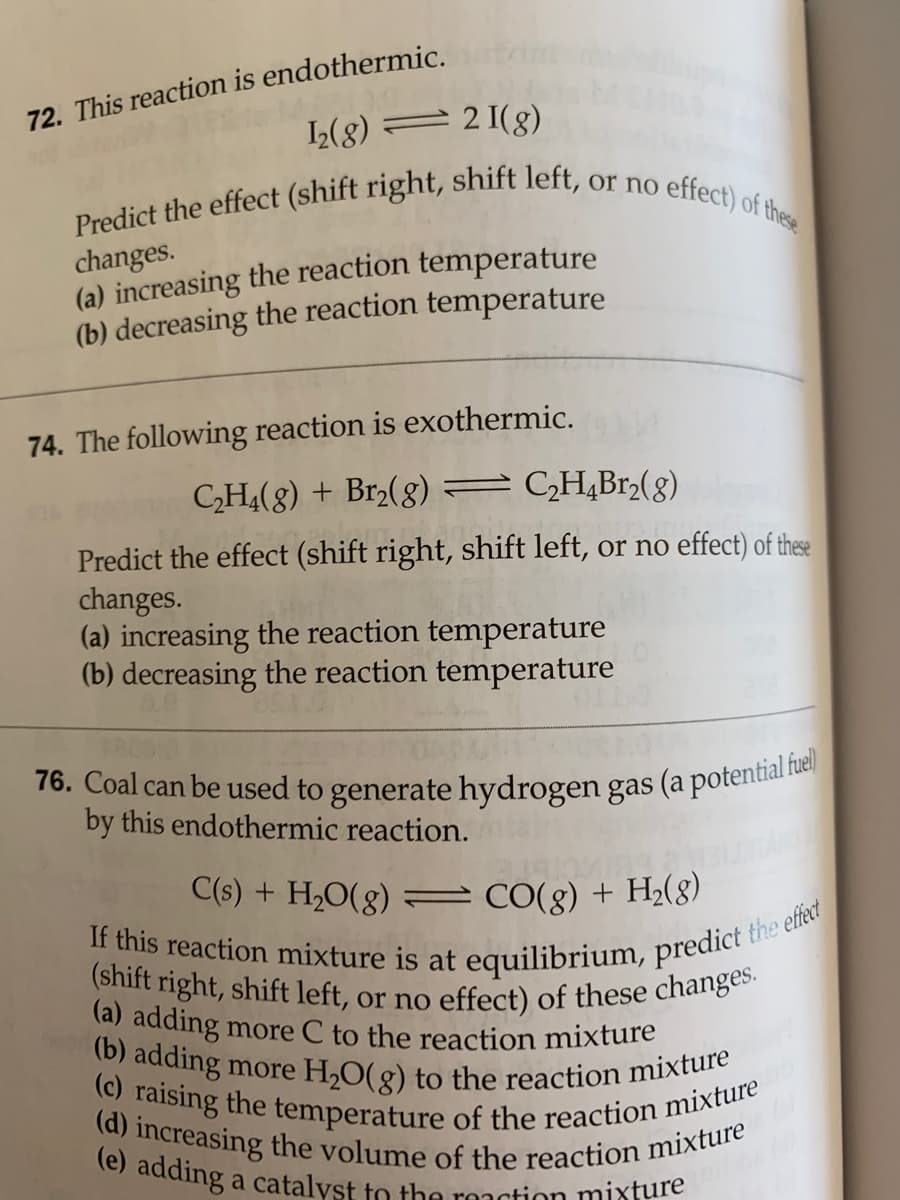74. The following react CH4(g) + Br2(8) = CH¿Br2(g) Predict the effect (shift right, shift left, or no effect) of these changes. (a) increasing the reaction temperature (b) decreasing the reaction temperature ntontial fuel)
74. The following react CH4(g) + Br2(8) = CH¿Br2(g) Predict the effect (shift right, shift left, or no effect) of these changes. (a) increasing the reaction temperature (b) decreasing the reaction temperature ntontial fuel)
Introduction to General, Organic and Biochemistry
11th Edition
ISBN:9781285869759
Author:Frederick A. Bettelheim, William H. Brown, Mary K. Campbell, Shawn O. Farrell, Omar Torres
Publisher:Frederick A. Bettelheim, William H. Brown, Mary K. Campbell, Shawn O. Farrell, Omar Torres
Chapter7: Reaction Rates And Chemical Equilibrium
Section: Chapter Questions
Problem 7.81P
Related questions
Question
#74

Transcribed Image Text:(shift right, shift left, or no effect) of these changes.
(c) raising the temperature of the reaction mixture
76. Coal can be used to generate hydrogen gas (a potential fuel)
If this reaction mixture is at equilibrium, predict the effect
(b) adding more H2O(g) to the reaction mixture
(d) increasing the volume of the reaction mixture
72. This reaction is endothermic.
= 2 I(g)
effect) of these
changes.
(a) increasing the reaction temperature
(b) decreasing the reaction temperature
74. The following reaction is exothermic.
CH4(8) + Br,(8) =CH,Br>(g)
Predict the effect (shift right, shift left, or no effect) of these
changes.
(a) increasing the reaction temperature
(b) decreasing the reaction temperature
by this endothermic reaction.
C(s) + H,0(8) = CO(g) + H2(8)
(a) adding
more C to the reaction mixture
te) adding a catalyst to the roaction mixture
Expert Solution
This question has been solved!
Explore an expertly crafted, step-by-step solution for a thorough understanding of key concepts.
This is a popular solution!
Trending now
This is a popular solution!
Step by step
Solved in 2 steps with 1 images

Knowledge Booster
Learn more about
Need a deep-dive on the concept behind this application? Look no further. Learn more about this topic, chemistry and related others by exploring similar questions and additional content below.Recommended textbooks for you

Introduction to General, Organic and Biochemistry
Chemistry
ISBN:
9781285869759
Author:
Frederick A. Bettelheim, William H. Brown, Mary K. Campbell, Shawn O. Farrell, Omar Torres
Publisher:
Cengage Learning


Chemistry: An Atoms First Approach
Chemistry
ISBN:
9781305079243
Author:
Steven S. Zumdahl, Susan A. Zumdahl
Publisher:
Cengage Learning

Introduction to General, Organic and Biochemistry
Chemistry
ISBN:
9781285869759
Author:
Frederick A. Bettelheim, William H. Brown, Mary K. Campbell, Shawn O. Farrell, Omar Torres
Publisher:
Cengage Learning


Chemistry: An Atoms First Approach
Chemistry
ISBN:
9781305079243
Author:
Steven S. Zumdahl, Susan A. Zumdahl
Publisher:
Cengage Learning

Chemistry
Chemistry
ISBN:
9781305957404
Author:
Steven S. Zumdahl, Susan A. Zumdahl, Donald J. DeCoste
Publisher:
Cengage Learning

Chemistry: The Molecular Science
Chemistry
ISBN:
9781285199047
Author:
John W. Moore, Conrad L. Stanitski
Publisher:
Cengage Learning

Chemistry for Engineering Students
Chemistry
ISBN:
9781337398909
Author:
Lawrence S. Brown, Tom Holme
Publisher:
Cengage Learning